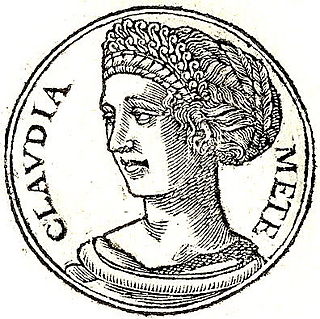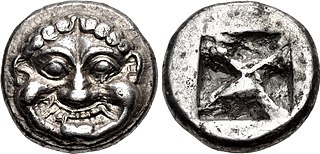The dodrans (a contraction of Latin dequadrans: "less a quarter") or nonuncium (from Latin nona uncia: "ninth twelfth") was an Ancient Roman bronze coin produced during the Roman Republic.
The dodrans, valued at three quarters of an as (nine unciae), [1] was produced only twice:
Dodrans as a unit may refer to a time span of forty-five minutes (three quarters of an hour) or a length of nine inches (three quarters of a foot).
It has also been used to refer to the metrical pattern – ᴗ ᴗ – ᴗ x, which constitutes the last three quarters of the glyconic line. [2] Also called the choriambo-cretic, the pattern is common in Aeolic verse.

Andriscus, also often referenced as Pseudo-Philip, was a Greek pretender who became the last independent king of Macedon in 149 BC as Philip VI, based on his claim of being Philip, a now-obscure son of the last legitimate Macedonian king, Perseus. His reign lasted just one year and was toppled by the Roman Republic during the Fourth Macedonian War.

Clodia, nicknamed Quadrantaria, Nola, Medea Palatina by Cicero, and occasionally referred to in scholarship as Clodia Metelli, was one of three known daughters of the ancient Roman patrician Appius Claudius Pulcher.

The history of ancient Greek coinage can be divided into four periods: the Archaic, the Classical, the Hellenistic and the Roman. The Archaic period extends from the introduction of coinage to the Greek world during the 7th century BC until the Persian Wars in about 480 BC. The Classical period then began, and lasted until the conquests of Alexander the Great in about 330 BC, which began the Hellenistic period, extending until the Roman absorption of the Greek world in the 1st century BC. The Greek cities continued to produce their own coins for several more centuries under Roman rule. The coins produced during this period are called Roman provincial coins or Greek Imperial Coins.
The bes was an Ancient Roman bronze coin produced during the Roman Republic. Valued at two thirds of an as, it was only produced in 126 BC by C. Cassius in combination with the dodrans, another very rare denomination which was valued at three quarters of an as. The obverse head displayed the god Liber facing to the right.
The Battle of Panormus was fought in Sicily in 250 BC during the First Punic War between a Roman army led by Lucius Caecilius Metellus and a Carthaginian force led by Hasdrubal, son of Hanno. The Roman force of two Roman and two allied legions defending the city of Panormus defeated the much larger Carthaginian army of 30,000 men and between 60 and 142 war elephants.

The Porticus Octaviae is an ancient structure in Rome. The colonnaded walks of the portico enclosed the Temples of Juno Regina (north) and Jupiter Stator (south), as well as a library. The structure was used as a fish market from the medieval period up to the end of the 19th century.

The Temple of Jupiter Stator, also known to the ancient Romans as the Temple of Jove Metellina and Metellus's Temple, was a temple dedicated to the Roman god Jupiter Stator. It was located beside the Temple of Juno Regina in the Porticus Octaviae in the southern Campus Martius before its destruction in the AD 64 Great Fire of Rome.

Quintus Caecilius Metellus was a pontiff in 216 BC, aedile of the plebeians in 209 BC, curule aedile in 208 BC, magister equitum in 207 BC, consul in 206 BC, dictator in 205 BC, proconsul of Bruttium in 204 BC, and an ambassador at the court of Philip V of Macedon in 185 BC.
Quintus Caecilius Metellus Balearicus was a Roman statesman and general who was elected consul for the year 123 BC.
Quintus Caecilius Metellus Nepos was a senator and consul.
Lucius Caecilius Metellus Delmaticus was a Roman politician and general. He was a son of Lucius Caecilius Metellus Calvus and brother of Quintus Caecilius Metellus Numidicus. He was consul in 119 BC; during his year, he opposed Gaius Marius' election procedures law. As consul and proconsul from 119–117 BC, he campaigned against the Dalmatians. For his victories, he triumphed in 117 BC, earning his cognomen and dedicating two temples – also contributing to repairs for the Temple of Castor and Pollux – from the spoils of war.
Gaius Caecilius Metellus Caprarius was a consul of the Roman Republic in 113 BC with Gnaeus Papirius Carbo. He served under Scipio Aemilianus in Numantia around 133 BC. He was praetor in 117 BC. His proconsulship in Thrace in 112–111 BC earned him a triumph. He was censor in 102 BC with his cousin, Quintus Caecilius Metellus Numidicus.

Quintus Caecilius Metellus Pius Scipio, often referred to as Metellus Scipio, was a Roman senator and military commander. During the civil war between Julius Caesar and the senatorial faction led by Pompey, he was a staunch supporter of the latter. He led troops against Caesar's forces, mainly in the battles of Pharsalus and Thapsus, where he was defeated. He later committed suicide. Ronald Syme called him "the last Scipio of any consequence in Roman history."
Caecilia Metella was a Roman matron of the first century BC, who belonged to the powerful family of the Caecilii Metelli. She was possibly the mother of Clodius.
Caecilia Metella was daughter of Quintus Caecilius Metellus Celer and Clodia. She was an infamous woman in Rome during the late Republic and a celebrity of sorts.

The gens Caecilia was a plebeian family at ancient Rome. Members of this gens are mentioned in history as early as the fifth century BC, but the first of the Caecilii who obtained the consulship was Lucius Caecilius Metellus Denter, in 284 BC. The Caecilii Metelli were one of the most powerful families of the late Republic, from the decades before the First Punic War down to the time of Augustus.
The gens Eppia was a minor plebeian family at Ancient Rome. It is known chiefly as a result of Marcus Eppius, a Roman senator, and partisan of Pompeius during the Civil War. He served as legate under Quintus Metellus Scipio, and later under Sextus Pompeius.
The gens Fulcinia was a minor plebeian family at ancient Rome. The first of this name to appear in history is Gaius Fulcinius, one of the ambassadors to Fidenae in 438 BC. After this, no Fulcinius is mentioned until the time of Cicero. Several Fulcinii are known from the first century BC, although it is not clear whether or how they were related to the ambassador.
The gens Hirtuleia was a minor plebeian family of equestrian rank at ancient Rome, which appears in history during the final century of the Republic, and under the early Empire.
Pseudo-Alexander was a Greek pretender who attempted to claim the throne of the ancient kingdom of Macedonia as Alexander VI after the defeat of the previous claimant, Andriscus against the Roman Republic during the Fourth Macedonian War. Like Andriscus, Alexander also claimed to be a son of the last legitimate Macedonian king Perseus.
Dodrans coin.